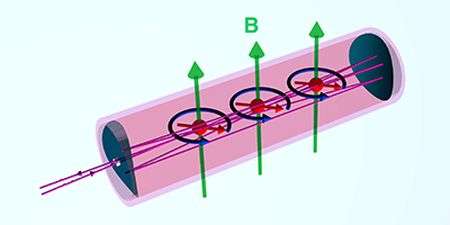April 26, 2013 report
New atomic magnetometer doesn't need to be shielded from Earth's magnetic field

(Phys.org) —Researchers from Princeton University in the U.S. together with colleagues from Zhejiang University of Science and Technology in China have developed a new kind of atomic magnetometer that is just as sensitive as others of its kind but doesn't need to be shielded from the Earth's magnetic field. The team reports on their new device in the journal Physical Review Letters.
Devices that can measure magnetic fields—magnetometers—are very useful in a wide variety of scientific applications. In recent years, such devices have been made more sensitive by using superconducting materials but they have the drawback of needing to be cryogenically cooled. Another approach has been to use atomic magnetometers—they don't have to be super-cooled, but they do need to have shielding put in place to prevent Earth's magnetic field from interfering with their readings. They work by using a pump laser to polarize the spin states of atoms inside the device. A probe laser is then used to read the spin precession once the device is ready to read a specific magnetic field—it's all based on the Zeeman Effect that is induced by an external magnetic field.
The new atomic magnetometer the group developed works essentially the same way as others of its kind, with two notable exceptions. The first is that the team uses a multi-pass cell—the probe laser makes many passes while reading the spin of the atoms in the device—typically rubidium vapor—this enhances the signal. The second difference is the team uses a technique to allow the polarizing to take place very quickly (within 1ms of laser pumping)—before relaxation of the spin states occurs. Doing so has the added benefit of helping to eliminate noise in the system allowing for more precise readings. The end result is an atomic magnetometer that is able to measure magnetism that is one hundred billion times smaller than the Earth's field, without the need for shielding.
Such a magnetometer is expected to be useful for such applications as measuring biological fields, geological instrumentation, experimental physics and even in land mine detection. The team that developed the new device isn't resting on its laurels, however, they are currently looking at ways to make the device smaller and more portable.
More information: Subfemtotesla Scalar Atomic Magnetometry Using Multipass Cells, Phys. Rev. Lett. 110, 160802 (2013) DOI: 10.1103/PhysRevLett.110.160802
Abstract
Scalar atomic magnetometers have many attractive features but their sensitivity has been relatively poor. We describe a Rb scalar gradiometer using two multipass optical cells. We use a pump-probe measurement scheme to suppress spin-exchange relaxation and two probe pulses to find the spin precession zero crossing times with a resolution of 1 psec. We realize a magnetic field sensitivity of 0.54 fT/Hz1/2, which improves by an order of magnitude the best scalar magnetometer sensitivity and exceeds, for example, the quantum limit set by the spin-exchange collisions for a scalar magnetometer with the same measurement volume operating in a continuous regime.
Journal information: Physical Review Letters
© 2013 Phys.org





















